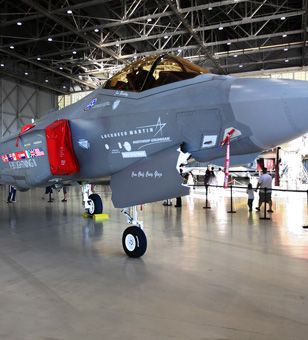Click here to support news free of corporate influence by donating to Truthout.
Tom Cruise steps onto the tarmac – cool and confident in his flight suit and dark aviator glasses. While his co-stars still call him Maverick, this isn’t “Top Gun” and that’s not an F-14 fighter plane. This is “Top Gun 2,” and the fighter plane he’s getting into is the F-35 Joint Strike Fighter (JSF) – the most expensive weapon ever, which is slated to be the mainstay of the US Navy, the Air Force and the Marine Corps.
While the recently announced “Top Gun 2” won’t be the F-35’s first movie appearance – an F-35 pilot tried in vain to kill Bruce Willis in “Live Free or Die Hard” – the announcement that it will be the plane of choice for Maverick’s triumphant return to the big screen has sparked controversy given the program’s celebrity-like exorbitant spending and breakdowns. The technology news web site Gizmodo quipped, “The first question: What will Tom Cruise do? Stand on a runway, staring at his grounded F-35?”
It’s not just technical problems that plague the plane. In March, the Department of Defense (DoD) released new estimates for how much the F-35 will cost over its lifetime and the price tag is staggering. The entire program is now expected to cost taxpayers nearly $1.51 trillion; that’s more than any weapon in history. Those costs grew by more than $100 billion from last year’s estimate.
Each individual plane is now estimated to cost $160 million – more than double the $74.5 million the DoD initially estimated they’d cost, and four times as much as the F-14 Tomcats that Maverick flew in the original movie.
There’s ample reason to believe that even these astronomical costs will only grow.
First, the DoD continues to lowball the cost to operate the program, meaning the estimated $1.11 trillion in F-35 operating costs for the F-35 will likely be tens of billions of dollars higher.
These cost estimates assume that the F-35 will not face major design changes. Yet “much of its developmental and operational testing remains and the risk of future design changes is significant,” the Government Accountability Office (GAO) recently warned. Major design changes mean increased costs. The GAO said some critical technologies were “not mature and present significant development risks” and a Pentagon review stated that there were major issues the combined impact of which “results in a lack of confidence in the design stability.”
The program’s exorbitant cost crowds out funding for other military needs. According to the GAO, the future procurement funding needed for the F-35 is “enough to fund the remaining procurement costs of the next 15 largest programs.” While it’s true that the F-35 is, by design, supposed to be a large program, it was also supposed to be affordable. But the dreams of a cheap F-35 are long in the past.
There is an alternative, however – the FA-18 E/F Super Hornet. Hundreds of billions of taxpayer dollars can be saved by replacing the most expensive and troublesome variants of the F-35 – the Navy and Marine variants – with Super Hornets (the Air Force variant is having markedly fewer problems and appears to be substantially cheaper than the other two).
While the Super Hornets lack the F-35’s stealth, the US military does not need this capability on all of its planes – the Air Force has stealthy F-22 fighters and its own variant of the F-35, as well as the B-2 stealth bomber and a planned new long-range bomber, not to mention the possibility of stealthy drones.
Otherwise, Super Hornets have many capabilities that rival the F-35. The F/A-18, unlike the F-35, is proven and has “established an extraordinary record in operations around the globe, in combat, under all kinds of conditions,” according to Adm. John Harvey, commander of US Fleet Forces Command. And, despite the recent crash in Virginia Beach, the plane’s mishap rate is, “as low as it’s ever been in naval aviation,” according to Rear Adm. Ted Branch, commander of Naval Air Force Atlantic.
Combine this with the fact that the Pentagon can buy three Super Hornets for the price of one F-35 Navy or Marine variant and these variants cost six times as much to fly as a Super Hornet and the choice is easy.
The F-35 may be a movie star, but it’s draining the Pentagon budget like Lindsay Lohan drains cocktails. The time has come for Congress and the Pentagon to stop believing that the F-35 program, in its current form of producing three variants, will ever deliver the capabilities it promised at a price taxpayers can afford and start considering viable options. Our economic and military security demands it.
Join us in defending the truth before it’s too late
The future of independent journalism is uncertain, and the consequences of losing it are too grave to ignore. We have hours left to raise the $12,0000 still needed to ensure Truthout remains safe, strong, and free. Every dollar raised goes directly toward the costs of producing news you can trust.
Please give what you can — because by supporting us with a tax-deductible donation, you’re not just preserving a source of news, you’re helping to safeguard what’s left of our democracy.
